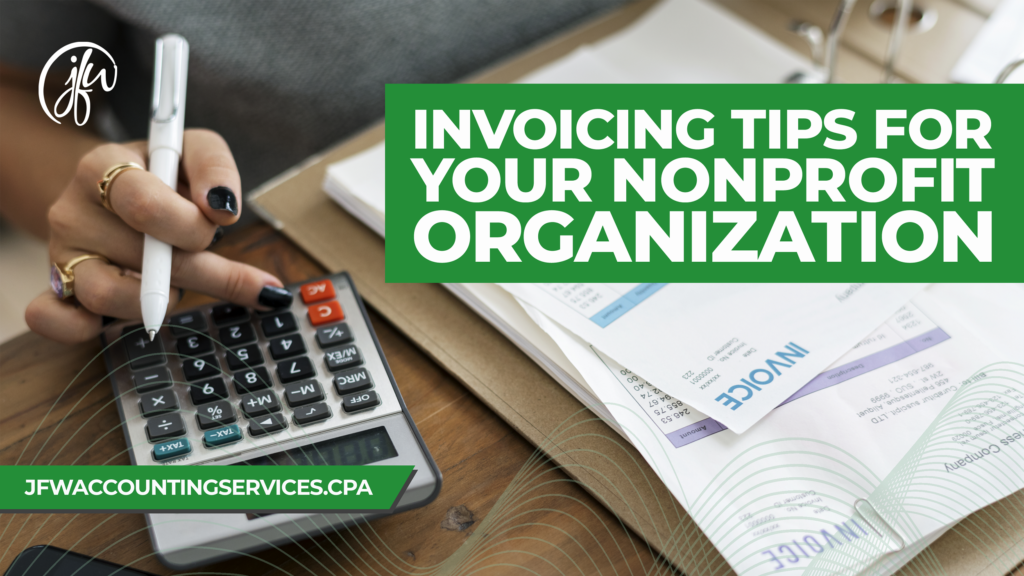What Is An Invoice?
Invoices are essential to all businesses, including nonprofit organizations, because they coordinate payment collection. An invoice shows products and/or services provided to a client. For nonprofits, common uses of invoices include requested or promised donations, registration fees, and payment obligations for membership dues.
Nonprofit organizations also need to invoice vendors, consultants, and other suppliers at times. An invoice gives formal notification of a payment request to the person receiving the document and provides a record of accounts receivable for the organization so that money to be collected can be tracked.
Invoicing is an important part of any nonprofit’s accounting function. A clear, consistent procedure helps the organization efficiently track funds. Keep reading for some useful invoicing tips you may want to implement at your organization.
Invoicing Tips
Make sure you have a clear and concise invoice template
An invoice should be presented as a professional document. Some necessary components of a complete invoice include the following:
Professional Header
Listing the organization’s name and contact information, including a phone number and email address
the client’s information – the name and contact details of the client who is receiving the invoice
Unique Identifier
Each invoice should have the invoice date and an identifier, like the invoice number.
Payment Due Date
Include the date payment is expected and the preferred payment method.
Each invoice sent should be in a uniform format. The easiest way to produce invoices is to use an invoice template. Some organizations choose to use one template for donations and a second for dues and services. Invoice templates can be found online or can be generated using the accounting software used by the organization.
Clearly list what services were provided and the associated cost
An invoice should be easy to understand and list details of what services, fees, or donations are expected. A description should be included for any services performed, including the applicable rate and the number of hours that are being billed for. If the invoice is for a donation, then details should list the terms of the donation as well as if the donor receives anything in return, like services or products. Each invoice should show a subtotal and a total, paying special attention to any taxes or additional fees charged.
Itemize any materials or supplies that were used in the project
Materials and supplies that were used to provide the service should be listed separately on the invoice. It can be tempting to incorporate the cost of materials in the rate of service, but this is not recommended. Materials and supplies should be listed separately with their cost and are usually subject to tax. The tax rates are dictated by the state in which the services were performed.
Send invoices as soon as the work is completed – don’t wait for the final payment
There is no need to wait for the end of a period or until all goods are received before sending an invoice. Invoices indicate an obligation, so it is beneficial to the individual or organization being invoiced to get the payment liability on their books as soon as possible. Issuing the invoice also marks the availability of that total as an asset, or accounts receivable, on the nonprofit’s accounting records. If the invoices are for an ongoing project or continued donations, they can be sent in parts. It is acceptable to send a weekly or monthly invoice for services provided which shows a balance due for previously invoiced services or materials.
Be professional and courteous when communicating with clients
Sending a professional invoice sets the tone and standard for the relationship between the organization and the client. The invoice should be professional and all communication following the issued invoice should follow suit. Nonprofits are unique in that they depend on donor relationships, so donation invoices should always be handled with care. Avoid stamping donor invoices “past due” or making collection calls regarding donations.
Keep good records of all payments received and expenses incurred
Making sure that invoices reflect actual services or goods received is an important part of keeping up an organization’s public reputation as well as accurate accounting records. At the time goods, services, or donations are received or promised, they should be recorded. Payments should also be recorded as soon as they are recorded. The process should be outlined as an organization-wide procedure so that outstanding payables always match the accounting records and clients, and donors are never asked for payments they’ve already made.
Conclusion
Maintaining a consistent invoicing procedure is a vital part of running a nonprofit organization. Professional invoices must be sent out with detailed information and accurate descriptions of what payment is for. Sending invoices timely and recording payments as soon as they are received will help keep accounting records accurate. The best way to manage invoices is to use great accounting software that will enable and track deposits, withdrawals, and send invoices. For more information about how your organization can get on top of invoicing procedures, contact JFW Accounting Services.

Jo-Anne Williams Barnes, is a Certified Public Accountant (CPA) and Chartered Global Management Accountant (CGMA) holding a Master’s of Science in Accounting (MSA) and a Master’s in Business Administration (MBA). Additionally, she holds a Bachelor of Science (BS) in Accounting from the University of Baltimore and is a seasoned accounting professional with several years of experience in the field of managing financial records for non-profits, small, medium, and large businesses. Jo-Anne is a certified Sage Intacct Accounting and Implementation Specialist, a certified QuickBooks ProAdvisor, an AICPA Not-for-Profit Certificate II holder, and Standard for Excellence Licensed Consultant. Additionally, Jo-Anne is a member of American Institute of Certified Public Accountant (AICPA), Maryland Association of Certified Public Accountants (MACPA), and Greater Washington Society of Certified Public Accountants (GWSCPA) where she continues to keep abreast on the latest industry trends and changes.

